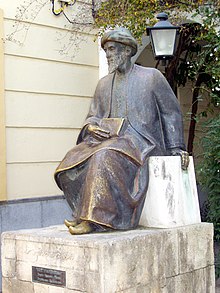Sephardic Jews
|
יְהוּדֵי סְפָרַד (Yehudei Sfarad)
|

|
Traditional:
Judaeo-Spanish (Ladino), Hebrew (liturgical), Andalusian Arabic, Judaeo-Portuguese, Haketia, Judaeo-Catalan, Judaeo-Occitan, Judaeo-Berber, Judeo-Arabic, Judaeo-Papiamento (in Curaçao)
Modern:
Modern (Israeli) Hebrew, Sephardi Hebrew (liturgical), Spanish, Portuguese, French, Dutch, Italian, Bulgarian, Greek, Turkish, Persian, other local languages |
| Judaism |
| Mizrahi Jews, Ashkenazi Jews, Hispanic Jews/Latino Jews, other Jewish ethnic divisions, and Samaritans |
Sephardic Jews (Hebrew: יְהוּדֵי סְפָרַד, romanized: Yehudei Sfarad, transl. 'Jews of Spain'; Ladino: Djudios Sefaradis), also known as Sephardi Jews or Sephardim,[a][1] and rarely as Iberian Peninsular Jews,[2] are a Jewish diaspora population associated with the Iberian Peninsula (Spain and Portugal).[2] The term, which is derived from the Hebrew Sepharad (lit. 'Spain'), can also refer to the Jews of the Middle East and North Africa, who were also heavily influenced by Sephardic law and customs.[3] Many Iberian Jewish exiled families also later sought refuge in those Jewish communities, resulting in ethnic and cultural integration with those communities over the span of many centuries.[2] The majority of Sephardim live in Israel.[4]
The Jewish communities of the Iberian Peninsula prospered for centuries under the Muslim reign of Al-Andalus following the Umayyad conquest of Hispania, but their fortunes began to decline with the Christian Reconquista campaign to retake Spain. In 1492, the Alhambra Decree by the Catholic Monarchs of Spain called for the expulsion of Jews, and in 1496, King Manuel I of Portugal issued a similar edict for the expulsion of both Jews and Muslims.[5] These actions resulted in a combination of internal and external migrations, mass conversions, and executions. By the late 15th century, Sephardic Jews had been largely expelled from Spain and scattered across North Africa, Western Asia, Southern and Southeastern Europe, either settling near existing Jewish communities or as the first in new frontiers, such as along the Silk Road.[6]
Historically, the vernacular languages of the Sephardic Jews and their descendants have been variants of either Spanish, Portuguese, or Catalan, though they have also adopted and adapted other languages. The historical forms of Spanish that differing Sephardic communities spoke communally were related to the date of their departure from Iberia and their status at that time as either New Christians or Jews. Judaeo-Spanish, also called Ladino, is a Romance language derived from Old Spanish that was spoken by the eastern Sephardic Jews who settled in the Eastern Mediterranean after their expulsion from Spain in 1492; Haketia (also known as "Tetuani Ladino" in Algeria), an Arabic-influenced variety of Judaeo-Spanish, was spoken by North African Sephardic Jews who settled in the region after the 1492 Spanish expulsion.
In 2015, more than five centuries after the expulsion, both Spain and Portugal enacted laws allowing Sephardic Jews who could prove their ancestral origins in those countries to apply for citizenship.[7] The Spanish law that offered citizenship to descendants of Sephardic Jews expired in 2019, although subsequent extensions were granted by the Spanish government —due to the COVID-19 pandemic— in order to file pending documents and sign delayed declarations before a notary public in Spain.[8] In the case of Portugal, the nationality law was modified in 2022 with very stringent requirements for new Sephardic applicants,[9][10] effectively ending the possibility of successful applications without evidence of a personal travel history to Portugal —which is tantamount to prior permanent residence— or ownership of inherited property or concerns on Portuguese soil.[11]
The name Sephardi means "Spanish" or "Hispanic", derived from Sepharad (Hebrew: סְפָרַד, Modern: Sfarád, Tiberian: Səp̄āráḏ), a Biblical location.[12] The location of the Biblical Sepharad points to the Iberian peninsula, then the westernmost outpost of Phoenician maritime trade.[13] Jewish presence in Iberia is believed to have started during the reign of King Solomon,[14] whose excise imposed taxes on Iberian exiles. Although the first date of arrival of Jews in Iberia is the subject of ongoing archaeological research, there is evidence of established Jewish communities as early as the 1st century CE.[15]
Modern transliteration of Hebrew romanizes the consonant פ (pe without a dagesh dot placed in its center) as the digraph ph, in order to represent fe or the single phoneme /f/ , the English sound that is voiceless labiodental fricative. In other languages and scripts, "Sephardi" may be translated as plural Hebrew: סְפָרַדִּים, Modern: Sfaraddim, Tiberian: Səp̄āraddîm; Spanish: Sefardíes; Portuguese: Sefarditas; Catalan: Sefardites; Aragonese: Safardís; Basque: Sefardiak; French: Séfarades; Galician: Sefardís; Italian: Sefarditi; Greek: Σεφαρδίτες, Sephardites; Serbo-Croatian: Сефарди, Sefardi; Judaeo-Spanish: Sefaradies/Sefaradim; and Arabic: سفارديون, Safārdiyyūn.

